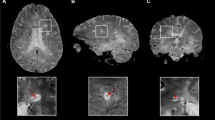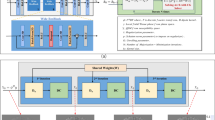Abstract
Purpose
We present a platform, GRAphical Pipeline Environment (GRAPE), to facilitate the development of patient-adaptive magnetic resonance imaging (MRI) protocols.
Methods
GRAPE is an open-source project implemented in the Qt C++ framework to enable graphical creation, execution, and debugging of real-time image analysis algorithms integrated with the MRI scanner. The platform provides the tools and infrastructure to design new algorithms, and build and execute an array of image analysis routines, and provides a mechanism to include existing analysis libraries, all within a graphical environment. The application of GRAPE is demonstrated in multiple MRI applications, and the software is described in detail for both the user and the developer.
Results
GRAPE was successfully used to implement and execute three applications in MRI of the brain, performed on a 3.0-T MRI scanner: (i) a multi-parametric pipeline for segmenting the brain tissue and detecting lesions in multiple sclerosis (MS), (ii) patient-specific optimization of the 3D fluid-attenuated inversion recovery MRI scan parameters to enhance the contrast of brain lesions in MS, and (iii) an algebraic image method for combining two MR images for improved lesion contrast.
Conclusions
GRAPE allows graphical development and execution of image analysis algorithms for inline, real-time, and adaptive MRI applications.







Similar content being viewed by others
References
Dhawan AP (2011) Medical image analysis, vol 31. John Wiley & Sons
Cox RW (1996) AFNI: software for analysis and visualization of functional magnetic resonance neuroimages. Comput Biomed Res 29:162–173
Avants BB, Tustison NJ, Song G, Cook PA, Klein A, Gee JC (2011) A reproducible evaluation of ANTs similarity metric performance in brain image registration. Neuroimage 54:2033–2044
Friston KJ, Holmes P, Worsley KJ, Poline J-P, Frith CD, Frackowiak RSJ (1995) Statistical parametric maps in functional imaging: a general linear approach. Hum Brain Mapp 2:189–210
Fedorov A, Beichel R, Kalpathy-Cramer J, Finet J, Fillion-Robin JC, Pujol S, Bauer C, Jennings D, Fennessy F, Sonka M, Buatti J, Aylward S, Miller JV, Pieper S, Kikinis R (2012) 3D Slicer as an image computing platform for the Quantitative Imaging Network. Magn Reson Imaging 30:1323–1341
Ibanez L, Schroeder W, Ng L, Cates J (2005) The ITK software guide. http://www.itk.org/ItkSoftwareGuide.pdf
Wolf I, Vetter M, Wegner I, Böttger T, Nolden M, Schöbinger M, Hastenteufel M, Kunert T, Meinzer HP (2005) The medical imaging interaction toolkit. Med Image Anal 9:594–604
Rex DE, Ma JQ, Toga AW (2003) The LONI pipeline processing environment. Neuroimage 19:1033–1048
Lucas BC, Bogovic JA, Carass A, Bazin PL, Prince JL, Pham DL, Landman BA (2010) The Java Image Science Toolkit (JIST) for rapid prototyping and publishing of neuroimaging software. Neuroinformatics 8:5–17
Zwart NR, Pipe JG (2014) Graphical programming interface: a development environment for MRI methods. Magn Reson Med 74:1449–1460
GraphMIC. http://www.re-mic.de/index.php/graphmic
Bitter I, Van Uitert R, Wolf I, Ibáñez L, Kuhnigk JM (2007) Comparison of four freely available frameworks for image processing and visualization that use ITK. IEEE Trans Vis Comput Gr 13(3):483–493
Gabr RE, Sun X, Pednekar A, Narayana PA (2016) Automated patient-specific optimization of three-dimensional double inversion recovery magnetic resonance imaging. Magn Reson Med 75:585–593
Bray T, Paoli J, Sperberg-McQueen CM, Maler E, Yergeau F (2008) Extensible markup language (XML) 1.0 (fifth edition). W3C Recomm 2008:1–38
Smith SM (2002) Fast robust automated brain extraction. Hum Brain Mapp 17:143–155
Tustison NJ, Avants BB, Cook PA, Zheng Y, Egan A, Yushkevich PA, Gee JC (2010) N4ITK: improved N3 bias correction. IEEE Trans Med Imaging 29:1310–1320
Collignon A, Maes F, Delaere D, Vandermeulen D, Suetens P, Marchal G (1995) Automated multi-modality image registration based on information theory. Inf Process Med Imaging 3:263–274
Avants BB, Tustison NJ, Wu J, Cook PA, Gee JC (2011) An open source multivariate framework for n-tissue segmentation with evaluation on public data. Neuroinformatics 9:381–400
Marcus DS, Olsen TR, Ramaratnam M, Buckner RL (2007) The Extensible Neuroimaging Archive Toolkit: an informatics platform for managing, exploring, and sharing neuroimaging data. Neuroinformatics 5:11–34
Milo R, Kahana E (2010) Multiple sclerosis: geoepidemiology, genetics and the environment. Autoimmun Rev 9:A387–A394
Sahraian MA, Eshaghi A (2010) Role of MRI in diagnosis and treatment of multiple sclerosis. Clin Neurol Neurosurg 112:609–615
Sweeney EM, Shinohara RT, Shiee N, Mateen FJ, Chudgar A, Cuzzocreo JL, Calabresi P, Pham DL, Reich DS, Crainiceanu CM (2013) OASIS is Automated Statistical Inference for Segmentation, with applications to multiple sclerosis lesion segmentation in MRI. NeuroImage Clin 2:402–413
Karimaghaloo Z, Shah M, Francis SJ, Arnold DL, Collins DL, Arbel T (2012) Automatic detection of gadolinium-enhancing multiple sclerosis lesions in brain MRI using conditional random fields. IEEE Trans Med Imaging 31:1181–1194
Datta S, Narayana P (2013) A comprehensive approach to the segmentation of multichannel three-dimensional MR brain images in multiple sclerosis. NeuroImage Clin 2:184–196
Sajja BR, Datta S, He R, Mehta M, Gupta RK, Wolinsky JS, Narayana PA (2006) Unified approach for multiple sclerosis lesion segmentation on brain MRI. Ann Biomed Eng 34:142–151
Gabr RE, Pednekar AS, Sun X, Narayana PA (2016) A framework for precision magnetic resonance imaging: initial results. In: IEEE-EMBS international conference biomedical and health informatics, Las Vegas, NV, USA, pp 276–279
Wiggermann V, Hernandez-Torres E, Traboulsee A, Li DKB, Rauscher A (2015) FLAIR2: a combination of FLAIR and T2 for improved MS lesion detection. Am J Neuroradiol 37(2):259–265
Gabr RE, Hasan KM, Haque ME, Nelson FM, Wolinsky JS, Narayana PA (2016) Optimal combination of FLAIR and T2-weighted MRI for improved lesion contrast in multiple sclerosis. J Magn Reson Imaging. doi:10.1002/jmri.25281
Lu H, Nagae-Poetscher LM, Golay X, Lin D, Pomper M, van Zijl PCM (2005) Routine clinical brain MRI sequences for use at 3.0 Tesla. J Magn Reson Imaging 22:13–22
Polak P, Magnano C, Zivadinov R, Poloni G (2012) 3D FLAIRED: 3D fluid attenuated inversion recovery for enhanced detection of lesions in multiple sclerosis. Magn Reson Med 68:874–81
Acknowledgements
This work was supported by the Clinical Translational Science Award (CTSA) Grant UL1 TR000371 from the e National Institutes of Health (NIH) National Center for Advancing Translational Sciences, and the Chair in Biomedical Engineering Endowment Funds. Stampede was generously funded by the National Science Foundation (NSF) through award ACI-1134872. We thank Xiaojun Sun for useful discussion and Vipulkumar Patel for help with the MRI experiments.
Author information
Authors and Affiliations
Corresponding author
Ethics declarations
Conflict of interest
The authors declare no conflict of interest.
Ethical standards
This research was approved by the Committee for the Protection of Human Subjects of the University of Texas Health Science Center at Houston.
Informed consent
Informed consent was obtained from all participants included in the study.
Additional information
In the original publication of this article the given name of Amol S. Pednekar has been published incorrectly; this error has now been corrected.
An erratum to this article is available at http://dx.doi.org/10.1007/s11548-016-1508-y.
Electronic supplementary material
Below is the link to the electronic supplementary material.
Rights and permissions
About this article
Cite this article
Gabr, R.E., Tefera, G.B., Allen, W.J. et al. GRAPE: a graphical pipeline environment for image analysis in adaptive magnetic resonance imaging. Int J CARS 12, 449–457 (2017). https://doi.org/10.1007/s11548-016-1495-z
Received:
Accepted:
Published:
Issue Date:
DOI: https://doi.org/10.1007/s11548-016-1495-z




